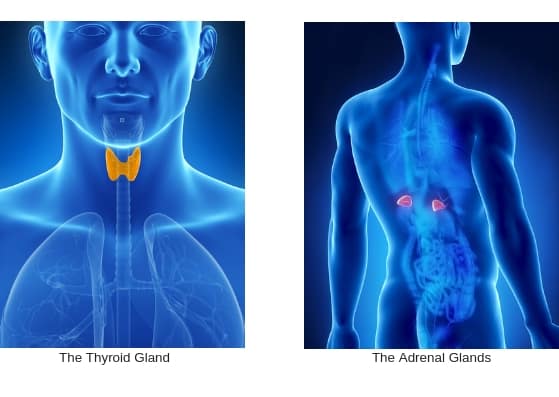Share this post
Restorative therapies from the animal kingdom for advanced thyroid and adrenal support
The many causes of fatigue
There’s usually no one “magic bullet” cure for fatigue. This is likely because there is usually no one consistent cause. Fatigue can arise from disrupted sleep patterns, infections, blood sugar imbalances, nutritional deficiencies, allergies, or air pollution. Fatigue can also be a symptom of more serious diseases.
That being said, in our fast-paced, high-stress society, our endocrine systems are under constant strain, with the thyroid gland (which sits at the front of the neck) and the adrenals (one of which sits atop each kidney) being particularly vulnerable. Thyroid and adrenal imbalances are commonplace, resulting not only in fatigue, but also brain fog, difficulty losing weight, sugar cravings, sports injuries, mood imbalances, and more.
When it comes to hypothyroidism and adrenal fatigue, targeted nutritional therapy may be of benefit, as can dietary changes, exercise, smoking cession, and herbal medicines.
In severe cases, however, pharmaceutical medications are sometimes needed to replace the deficient hormones. In cases of hypothyroidism, thyroid replacement hormone may be necessary.[1] In the event of adrenal issues, many benefit from pharmaceutical hydrocortisone.[2] Isolating active constituents and single hormones are highly effective in supplying just that one thing, however. And sometimes we have endocrine issues that are severe enough to slow us down, but not dramatic enough to necessitate pharmaceuticals – what do we do in those cases?
What part of a gland needs nourishing?
And what about when more than just one hormone is lacking? For example, patients with chronic fatigue syndrome and adrenal fatigue undoubtedly need adrenal support, but what part of the gland needs nourishing? Is it the adrenal cortex, the outer part of the gland? And if so, which layer of the cortex? Is it the layer that produces aldosterone (which balances blood pressure and mineral balance) or the one that makes cortisol (the hormone that gives us energy)? Or is it the deepest layer, which makes the precursors to sex hormones?
But what if the patient is suffering from symptoms that could be helped by supporting all three layers of adrenal cortex? They’d have to take three separate drugs or more to get the nourishment they need! The adrenal medulla, or center of the gland, is also of importance, as it produces the catecholamines dopamine, epinephrine, and norepinephrine.[3]
Patients with Lyme disease, chronic fatigue syndrome, adrenal fatigue, and severe viral illnesses often have symptoms potentially caused by dysfunction in many different regions of the adrenal gland. The constellation may look like exhaustion, poor focus, brain fog, poor sleep quality or the need for excess sleep, dizziness if they stand up too quickly, low blood pressure, and cravings for salt, sugar, and/or fat. It is perhaps for this very reason that many functional medicine practitioners strive to support every part of the tissue, and not just one component of it.[4]
Patients with Lyme disease, chronic fatigue syndrome, adrenal fatigue, and severe viral illnesses often have symptoms potentially caused by dysfunction in many different regions of the adrenal gland.
But how do we do that? One approach is that of glandular therapy, or organotherapy. Affectionately known as “beasty bits,” glandular preparations are made using the entire gland of an animal to support the corresponding gland in a human. For example, somebody with sub-clinical hypothyroidism may choose to take a thyroid glandular product, which, like pharmaceutical desiccated thyroid hormone, is prepared from the thyroid gland of a mammal. (Also note that synthetic thyroid replacement hormone exists, which is not derived from animal tissue.) Unlike pharmaceutical thyroid replacement, however, thyroid glandular products deliver the hormonal precursors and other nutrients associated with the thyroid, thereby gently and holistically supporting the body in its return to equilibrium.[5] It’s no surprise, then, that we tend to see fewer adverse reactions to glandular therapies than to pharmaceutical drugs.
Thyroid glandular products deliver the hormonal precursors and other nutrients associated with the thyroid, thereby gently and holistically supporting the body in its return to equilibrium.
The broad range of effects of glandulars
It has been shown that the peptide macromolecules found in glandular products are absorbed intact from the digestive tract, conferring measureable effects.[6],[7],[8] Glandulars are thought to provide growth factors that stimulate regeneration of similar tissue and likely contain the enzymes secreted by those tissues.[9] The organs and glands of animals have a different nutritional composition than the flesh (or meat) of animals, and are rich in the vitamins and minerals naturally found in the tissues.[10],[11],[12] All of this makes glandular preparations both potent and broad-acting. As compared to hormone replacement therapy, glandulars offer us breadth over depth, and for this reason are potentially suitable for a wider array of people, such as those with sub-clinical (or mild) hormonal imbalances.
To learn more about glandular therapy and how it may help strengthen the immune system, check out this article.
Click here to see References
[1] Ross DS. Treatment of primary hypothyroidism in adults [Internet]. Waltham (MA): UpToDate; 2018 (cited Nov 1, 2018). Available from: https://www.uptodate.com/contents/treatment-of-primary-hypothyroidism-in-adults
[2] Nieman LK. Treatment of adrenal insufficiency in adults [Internet]. Waltham (MA): UpToDate; 2018 (cited Nov 1, 2018). Available from: https://www.uptodate.com/contents/treatment-of-adrenal-insufficiency-in-adults
[3] Roman S, Wu L. Surgical anatomy of the adrenal glands [Internet]. Waltham (MA): UpToDate; 2018 (cited Nov 1, 2018). Available from: https://www.uptodate.com/contents/surgical-anatomy-of-the-adrenal-glands
[4] Murray M. Glandular extracts. New Canaan, CT: Keats Publishing; 1994.
[5] Schmid F, Stein J. Cell research and cellular therapy. Thoune, Switzerland: Ott Publishers; 1960.
[6] Gardner MJ. Gastrointestinal absorption of intact proteins. Ann Rev Nutr. 1988;8:329-50.
[7] Gardner ML. Intestinal assimilation of intact peptides and proteins from the diet—a neglected field? Biol Rev. 1984;59:289-331.
[8] Amoss MS, et al. Release of gonadotrophins by oral administration of synthetic LRF or tripeptide fragment of LRF. J Clin Endocrinol Metab. 1972;35:175-7.
[9] Kouttab NM, et al. Thymomodulin: biological properties and clinical applications. Med Oncol Tumor Pharmacother. 1989;6(1):5-9.
[10] Fallon S. Proteins. In: Nourishing Traditions. Washington, DC: New Trends Publishing, Inc.; 2001:26-33.
[11] Marz R. Iron. In: Medical Nutrition from Marz. 2nd ed. Portland, OR: Omni-Press; 2002:114-9.
[12] Marz R. Vitamin B-12 (Cobalamin). In: Medical Nutrition from Marz. 2nd ed. Portland, OR: Omni-Press; 2002:220-5.
The information provided is for educational purposes only. Consult your physician or healthcare provider if you have specific questions before instituting any changes in your daily lifestyle including changes in diet, exercise, and supplement use.
Share this post
Dr. Erica Zelfand
Related posts
Cardiovascular Health and Lipoprotein(a)
Addressing a genetic issue and supporting cardiovascular health naturally Anyone who has ever listened to his or her own heart with a stethoscope has likely found the lub-dub pattern reassuring. The rhythmic regularity of the heart at rest can lull us into meditation, much like it helps an infant go to sleep, while the…
Movember: Taking Focus On Prostate Nutrition
Because food is medicine for EVERY part of the body It’s that time of year again. And no, we aren’t speaking of pumpkin-flavored everything, the far-too-early Christmas advertisements, or the need to scrape frost from the car windshield in the morning. It’s Movember – a movement designed to raise awareness of male health issues,…
Zinc for Immunity and Healthy Aging
Zinc is an essential nutrient for immunity and healthy aging Zinc is a trace mineral that is essential for growth, reproduction, and good health throughout life.[1],[2],[3] It is required for the structure and function of literally thousands of different proteins, including enzymes, transporters, and transcription factors.[4],[5] One of the most important roles of zinc…
Health Benefits of Alpha-Lipoic Acid
Its use in weight management, metabolic syndrome, and diabetes Alpha-lipoic acid (ALA), also known simply as lipoic acid, is a naturally-occurring substance that is an essential cofactor for several enzymes.[1] ALA, synthesized in the body from a medium-chain fatty acid known as octanoic acid,[2] plays a key role in mitochondrial metabolism and energy production.[3],[4]…
Does the Paleo Diet Really Work?
A critical review of the evidence One of the most controversial diets in recent times is the Paleolithic (“Paleo”) diet, also known as the Stone Age diet. The Paleo diet seeks to address 21st century ills by revisiting the way humans ate during the Paleolithic era, more than 2 million years ago. As a…
Is the Mediterranean Diet is Really Good For You?
A literature review on this increasingly popular diet What exactly is the Mediterranean diet? The Mediterranean diet (MD) is one of the better known and well-studied dietary patterns that has consistently been shown to have a beneficial influence on health and longevity.[1],[2],[3],[4] It is recognized by the World Health Organization as a healthy and…
Categories
- Botanicals (56)
- GI Health (53)
- Healthy Aging (121)
- Immune Support (39)
- In The News (39)
- Kids Health (21)
- Stress and Relaxation (50)
- Uncategorized (1)
- Video (9)
- Vitamins & Minerals (51)






